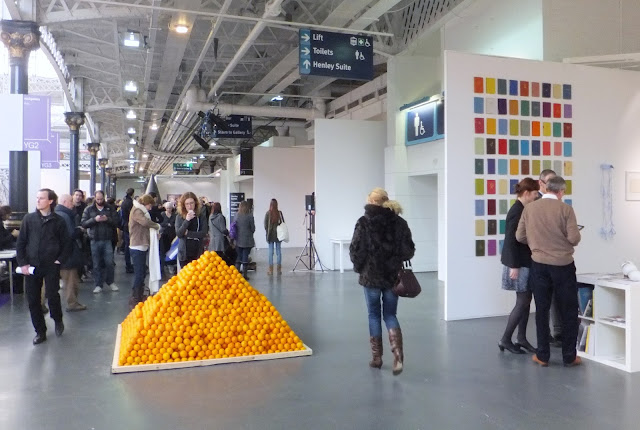London's art calendar may seem crowded, but since the demise of Zoo, which used to run simultaneously with Frieze, the latter has been London's only substantially-sized, pluralistic, internationally-focused fair. That's actually quite a contrast to the multiple satellites around the main fair is in Basel, New York or Miami.
 |
| Looking up the Grand Hall's roof over Zhu Jinshi's paper boat and a flash of El Anatsui's wall hanging |
Either way, the first edition of Art13 (1-3 March, sponsored by Citibank) had a positive vibe, especially on the opening night when 6,000 attended. Olympia's iron-framed, high-roofed Victorian Grand Hall provided an airy context with attractive natural lighting – indeed, several people suggested to me it was the finest artwork on view. The layout was spacious, with judicious use of 22 mostly sculptural and mostly excellent special projects to punctuate the Gallery Booths. Some spirited performances took place against Bedryr Williams' backdrop: an historic scene which showed a crowd ready to witness a hanging, complete with a woman hawking ghoulish souvenirs. Any coincidence with the art fair business was as cheekily deliberate as the Welshman tends to be.
 |
| Alice Anderson leads her troop of wire-wrappers in front of Bedryr Williams' Tyburn backdrop |
There were talks on international trends, and an impressive London-wide program for collectors. Things ran smoothly, consistent with the organisers having already had a hit with last year’s art
 |
| The booth of Torch (Amsterdam) showing Terry Rodgers |
That was a deliberate mission, which translated into numerically strong representation from Asia in particular, and played neatly into the programmes of London galleries specialising in the Far East (Hua, Rossi & Rossi, Selma Feriani) or Africa (Jack Bell, October) as well as visiting galleries. There was also a broad spread across different market sectors: alternative spaces, mainstream contemporary, second market galleries, editions, a smattering of street art. There were separate sections of young galleries (less than six years old) and galleries showing in London
 |
| View with Roelof Louw's take-an-orange pyramid and Peter Wüthrich's installtion of 99 colourfully-covered books |
But, to cut to the chase, was the art any good? The quality was variable, to be sure, but for every booth which encouraged me to move on quickly, there was another which drew me in. Some patchiness is probably inevitable if such a novel mix is to be achieved, but there were, for example, good displays from some of London's more adventurous smaller galleries (such as IMT, Maria Stenfors, Riflemaker, DOMOBAAL, Man & Eve, Ceri Hand, Salon Vert, Hidde van Seggelen and FOLD).
Was it a commercial success? Most galleries I spoke to said that sales had exceeded expectations, and all said that the organisers had made a good job of bringing collectors to the fair. Overall, then, Art13 is hardly a competitor to Frieze, but it does complement it, and it seems to be off to a successful enough start to look to next year with some confidence.
It wasn’t difficult to generate examples of interesting work by nine artists who have shown little if at all in London before – plus more familiar imposters from Newcastle via Scotland who I’ve allowed as my pick of the multiples.
No doubt the travel associated with an international art career can be a distraction, but China’s Yin Xiuzhen has made the most of it with a series of cities in a suitcase: she asks the relevant show’s curators to iv her some of their clothes, and turns them into her next destination’s architecture. Here, Madrid.
It wasn’t difficult to generate examples of interesting work by nine artists who have shown little if at all in London before – plus more familiar imposters from Newcastle via Scotland who I’ve allowed as my pick of the multiples.
Yin Xiuzhen: Portable Cities: Madrid, 2012 at Alexander Ochs Galleries (Berlin/Beijing)
Žilvinas Kempinas: Fountain, 2011 - Art Project presented by Gallery Vartai (Vilnius)
Pierre-Alain Münger: 275 / face 3, 2012 at Ivo Kamm (Zurich)

Swiss artist Pierre-Alain Münger explores destructive forces. This, described as 'car on metal', may be the ultimate action painting: it provides a surprisingly clear impression of what happened when face 3 (ie the front) of a white Jaguar impacted at over 100 kph into a sheet of green metal set up at the end of a crash test track.
Szilárd Cseke: Change of the System, 2013 at the Ani Molnár Gallery (Budapest)

Szilárd Cseke maps the post-socialist situation in Hungary
Michael Conrads: Tropic of Cancer, 2012 at ph – projects (Berlin)
Jane and Louise Wilson: False Positive, False Negative , 2012 at Dundee Contemporary Arts

This screen print on mirrored acrylic uses CCTV footage of the assassination of a Hamas operative in a Dubai hotel room, over which the artists appear with dazzle camouflage designed to scramble the technology used by police for digital face recognition: troubling, primitive, haunting, mysterious.
Ravinder Reddy: Untitled Bass Relief, 2011 at Gallery Minsky (Paris)
Indian artist Ravinder Reddy’s work tends to be described as ‘Pop goes Hindu’ for its melding of the archaic with a modern, wide-eyed directness and sensuality. Here that came in three uplifting permutations of the same four colours in what turned out to be polychrome bronze rather than his more usual fibreglass.
Jae Yong Rhee: Memories of the Gaze, 1993-2012 at Gallery EM (Seoul)

Philosophically trained New York
Su Xiaobai: Wagong No. 26, 2011 at Pearl Lam Galleries (Shanghai / Hong Kong)
Images courtesy the relevant galleries and artists








No comments:
Post a Comment
Note: only a member of this blog may post a comment.